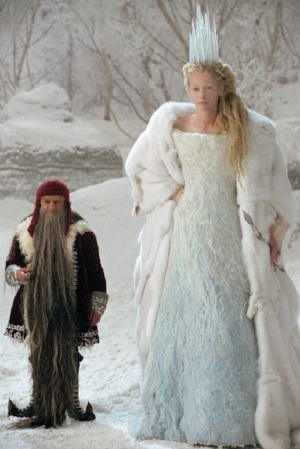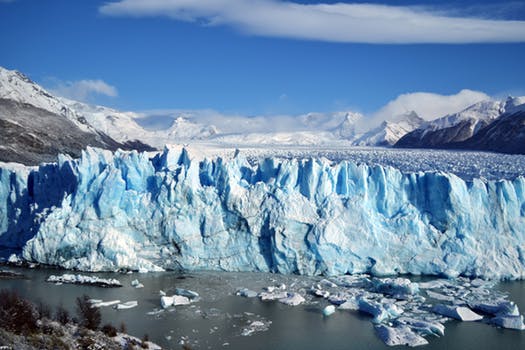Amanda Baldeneaux: Warm Snow & Poison Feasts in The Lion, The Witch and The Wardrobe
C.S. Lewis’s classic children’s tale about a magically resurrecting lion and four curious children is set in a weather pattern that is unfamiliar to me as I type this: Narnia is trapped in eternal winter, while here, on the Colorado Front Range, we are trapped in an eternal 60-degree late summer. I’d trade the Pevensies right now.
Never-ending winter in Narnia has been brought about by the White Witch, her Imperial Majesty Jadis, a grinch of a woman with no fondness for holiday festivities (although in Santa fashion she does favor elves as a source of cheap labor). The littlest Pevensie, Lucy, first discovers Narnia when a wardrobe in an otherwise empty room attracts her attention during an exploration of a large English manor house. Lucy likes that the wardrobe is full of coats, because “there was nothing Lucy liked so much as the smell and feel of fur.” Let’s cut straight to the metaphor and say Lucy is in touch with her “wild” nature. The manor house is the opposite of wild: a manicured, structured shell housing an eccentric professor and tourists who come for the architecture, antiques, and flowers. What child wouldn’t want to escape that kind of stuffery?
Lucy and her three older siblings have been sent to the house for safekeeping during the war (it’s always seemed odd to me, that in that giant house, there was no room for either of their parents, or at least their mother, if their father was fighting in WWII). After stepping into the wardrobe (and leaving the door open, as the narrator reminds us not once but three times “she knew that it very foolish to shut oneself into any wardrobe”) and pushing through the many hung fur coats, Lucy steps out into snow and a quiet wood. Strange, to be sure, but also enchanting and wild, so Lucy goes with it.
The first creature Lucy meets is Mr. Tumnus, a faun. Ignoring conventional wisdom about grown men-like creatures inviting little girls places, Mr. Tumnus implores Lucy to join him for tea in his home: an underground cave stocked with a buffet of boiled eggs, sardines on toast, buttered toast, toast with honey, and sugar-topped cakes. I’m reminded of both Persephone’s capture into the underworld where one taste of a pomegranate seed would damn her fate forever, as well as Guillermo Del Toro’s film, Pan’s Labyrinth, and the monstrous Pale Man, with his underground feast that dooms the eater.
Narnia is populated by creatures of Greek myth, from fauns to nymphs, to dryads, and “Bacchus himself,” who could make Narnia’s streams “run with wine instead of water”—a wild place, indeed. Lucy, the youngest child known for storytelling and a wild imagination, fits right in, while knowing—as we were thrice told—that one should never lock themselves completely into the wild spaces of our primitive hearts.
The third youngest Pevensie child, Edmund, is not as smart. When Edmund goes looking for Lucy during a game of hide and seek, he “jumped in and shut the door forgetting what a very foolish thing this is to do.” Locked inside the (his) wildness, Edmund’s first encounter is with the White Witch herself, a Pale Man in her own right, with magic Turkish Delight that poisons the mind of the eater. As Edmund eats and sets himself and his siblings up for attempted murder, he falls deeper under the White Witch’s spell as she promises to make him a prince of Narnia, a title the ever-slighted middle child feels he deserves. Sitting in the Queen’s icy sledge, Edmund feels warm and wanted, harkening to the lies of Akira Kurosawa’s Woman of the Snow in the film Dreams. The Woman of the Snow, a black-haired evil spirit, presses lost mountain climbers into the snow in the midst of a blizzard, insisting that “the snow is warm, the ice is hot.” To believe her would be death for the mountaineers. In Narnia, Edmund falls prey to the Witch’s deception, choosing death in trade for candy and false promises.
As I sip my hot coffee in front of a fire I don’t need on this unseasonably warm day following the election of Doug Jones and the near-miss defeat of Roy Moore in Alabama (my birth state, holla), I’m reminded of how dangerous the lure of false promises can be, when believing that “snow is warm” is far more comfortable than waking and facing the blizzard. As Lucy warns us three times over, one should never trap themselves into their own delusions, and one should never, ever, succumb to the belief that anything—including winter—is forever.
Sean Cassity: Stay Inside with The Shining, but Make Sure You Can Get out if You Need to
Others have written about The Shining on this site before, but if there ever was a cold weather classic in the horror genre, The Shining is it. You could make an argument for Lovecraft’s At the Mountains of Madness, but the cold barely figures into the plot or the psychology of the fear. In Lovecraft’s tale, Antarctica is chosen as the setting largely for its remoteness, and its vast, unexplored regions. It’s a place where monsters could have existed for eons undiscovered by humans.
In The Shining, the vicious cold is what turns the Overlook Hotel into an inescapable island, a prison, a death trap. Wendy and little Danny Torrance don’t battle the weather. It’s not even an option, because neither are outfitted for that kind of escape. A few hours’ exposure to the frozen alpine world beyond the hotel doors is certain death. They might as well leap from the roof’s highest peak and hope to sprout wings before they hit the ground as try march out into that weather. The cold contains them. The power the hotel has over them, the menace it creates by possessing Jack, is largely a consequence of that frozen storm outside. Otherwise, Wendy and Danny would just leave.
To the Overlook’s summer staff, being trapped by the cold is what did in the prior caretaker and his unfortunate family. Cabin fever, they called it. Poor, old Grady couldn’t bear being snowed in and he just snapped. Figured he would rescue his wife and kids the only way you really can when you’re all snowed in together. That’s what they supposed, anyway.
The cold is also responsible for that ticking time bomb in the Overlook’s basement—the boiler which needs to have some pressure released from its bowels every so often. Of course, when you are recently possessed and trying to murder your loved ones, it is not easy to remember all of your duties as a caretaker. Some things are bound to slip your mind.
The Shining is a good book to pick up on any cold winter’s night. It can help you consider, as you stare out the dark window, looking over the snow, what escape plans your family might have if something got into you, and how you could help them make those plans resistant to any sabotage. Best take the time to do these things while you are still of sound mind.
CS Peterson: The Left Hand of Darkness Is Light and Darkness the Right Hand of Light
Ursula K. Le Guin’s classic novel, The Left Hand of Darkness is the perfect book to read when the weather turns cold—the story is set on the planet Winter, a world of ice and snow. Like all great literature, this book ages well. I’ve read it four times now, and with each reading the story remains as fresh as the first time I encountered it, uncannily prescient and relevant to the present, though it was published in 1969.
The first time I read The Left Hand of Darkness, I was newly come to both Alaska and to puberty. The strange sexuality of the Gethenians (the inhabitants of Winter) blinded me to almost everything else in the story—it’s what you think about when you’re 14. The Gethenians are the very definition of “gender fluid.” They have a monthly cycle of coming into heat, which they call kemmer. During the days of kemmer individuals pair off, one becoming female and one male with no predictable pattern. The human protagonist, Genly Ai, is a man, and viewed by the Gethenians with some distaste as one always in heat.
When I read the book again in college, it was the politics that captured my attention. Genly Ai’s travels take him through two of Winter’s nations. In Karhide, Genly meets Estraven, the Gethenian protagonist, who is the prime minister there. Karhidishians speak in a heavily coded language of subtlety and implication. They circle around and around the truth, never arriving at it but never actually telling a lie. The other nation is Orgoreyn, where politicians smile broadly and have no trouble at all lying through their teeth.
Years later, it was the world-building of Winter that hooked me. The world is so richly drawn that it’s hard to believe the book is not an ethnography of an real alien world. Le Guin crafts whole cultures in minute detail. The characters of the novel walk through multiple faith traditions, cosmologies, epics, histories, and social and political structures without the narrative ever falling into pedantry. Le Guin is a master. The magnificent depth of interwoven language, image and character confirm for me, again and again, that this is a stunning work of literature, speculative or otherwise.
The Left Hand of Darkness begins with an image of a bridge over a wild river. It is a new bridge, and the king is setting the keystone in its place, not with a ceremonial daub, but with the slow, methodical work of a mason, using a mortar tinted pink with sacrificial blood. Our two main characters stand next to each other watching the king work. Genly Ai has come, alone, as an envoy from an interplanetary federation to tell the people of this frozen world that they are not alone in the universe. His mission is to invite them to join the larger human family. Estraven believes Genly and advocates for him with the king.
The story is filled with raging rivers, impassible canyons, glacial fissures, and vast stretches of interstellar time and space. It dwells on the distance between human beings who are alien to one another. The characters seek, and often must build, bridges, but every bridge exacts a terrific sacrifice.
The jewel of Le Guin’s novel is the trek Genly and Estraven make across an ice sheet 800 miles wide. It comprises a full quarter of the story. The relationship they build on the ice is fragile, and costly. There is never complete understanding between them. Le Guin gives use the same scene, first from Estraven's perspective, and then from Genly's. They do not see things the same way. But there is trust that grows into the deep love of friendship, and an absolute acceptance of each other’s alien reality.
The characters’ journey across the ice sheet reminds me of a sign in Rocky Mountain National Park warning hikers that “The Mountains Don’t Care.” On the planet Winter, it’s the ice that doesn’t care. The frozen landscape and the weather it creates are indifferent. Genly says that the screaming wind will “drive me to screaming back.” Estraven replies: “No use. It will not listen.”
Ice has innumerable ways to terrify and destroy, and yet its beauty borders on the mystical. When Genly looks back on his time with Estraven on the ice, he sees it as a gift: “What I was given was the thing you can’t earn, and can’t keep, and often don’t even recognize at the time; I mean joy.” Their time together on the ice has the quality of being quiveringly alive.
The Gethenians have perfected the art of foretelling. At the start of the novel, Genly, anxious about the future, seeks to answer the question of whether or not his mission to bring Winter into the galactic community will be successful. But the answer doesn’t matter. In the faith of the Gethenians, presence and the resultant foretelling is practiced to demonstrate the “perfect uselessness of knowing the answer to the wrong question.” Faxe, a Gethenian foreteller, explains:
“We shall die. There is really only one question that can be answered and we already know the answer … The only thing that makes life possible is permanent, intolerable uncertainty: not knowing what comes next.”
Our current unfounded belief in the possibility of perfect control and perfect certainty of outcomes is at odds with the Gethenians’ embrace of uncertainty. It’s a difficult lesson for Genly Ai, but at the end of the novel, when he makes a crucial choice, he says: “I did not know if I had done right. I had come to accept such uncertainties with a quiet heart.” In my own life, as I send my children and my students out into the world, I have that same feeling, though I’m still working on the bit about accepting uncertainty with a quiet heart.
Perito Moreno glacier. Photo by Bruno Camargo
If uncertainty is the thing that makes life possible, then stories are what make life bearable. When Genly and Estraven leave the ice sheet, Genly writes: “the saga is over, it belongs to the ice … There was no more joy in us.” He understands that the journey has become a tale. Later, at an Inn, Estraven relates the tale to a rapt audience, and we see the lived experience of the two characters transform into the cannon of myth before our eyes:
“He told it as only a person of an oral-literature tradition can tell a story, so that it became a saga full of traditional locutions and even episodes, yet exact and vivid, from the sulphurous fire and dark of the pass between Drumner and Dremegole to the screaming gusts from mountain-gaps that swept the Bay of Guthen; with comic interludes, such as his fall into the crevasse, and mystical ones, when he spoke of the sounds of silences of the Ice, of the shadowless weather, of the night’s darkness. I listened as fascinated as all the rest, my gaze on my friend’s dark face.”
Life is uncertain in every season, especially in winter, and the only absolute truth we have is the knowledge that we will die. As our planet warms and nations shake their sabers, I find myself wondering: are we willing to pay the steep price of building bridges over the the chasms of genders, faiths, political parties, nationalities?
Building bridges is not easy, especially when we are trapped by our assumptions and the ways we have learned to see ourselves and the world. Building bridges requires vulnerability, risk, a new way of seeing. Metaphorically, it is like traveling alone to a distant planet, to become a stranger in a strange land. In Le Guin’s novel, Estraven asks Genly why he came alone to Winter. Genly replies:
“I thought it was for your sake that I came alone, so obviously alone, so vulnerable, that I could in myself post no threat, change no balance: not an invasion, but a mere messenger boy. But there’s more to it than that. Alone, I cannot change your world. But I can be changed by it. Alone, I must listen, as well as speak. Alone, the relationship I finally make, if I make one, is not impersonal and not only political: it is individual it is personal, it is both more and less than political. Not We and They; not I and It; but I and Thou. Not political, not pragmatic, but mystical.”
In the dark of this winter, as we write our hopes and resolutions for the spring, my hope is that one by one we listen to each other. That we see each other individually, as humans first, before we see all that divides us. For better or worse we are all part of a unified whole, a single family of close and bickering kin, clinging to our tiny fragile world, floating in a void that is unimaginably vast.



















In the crucible of catastrophe, we learn deeper truths about love, loyalty, and compassion.